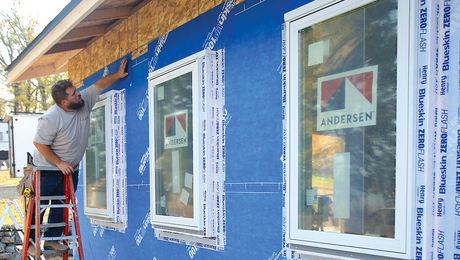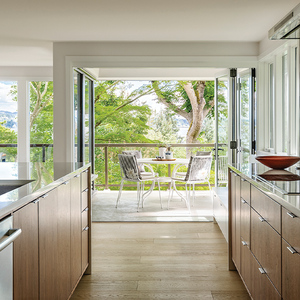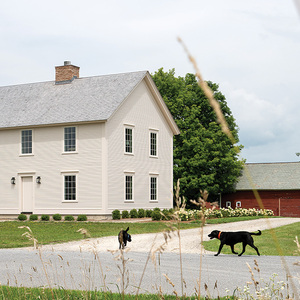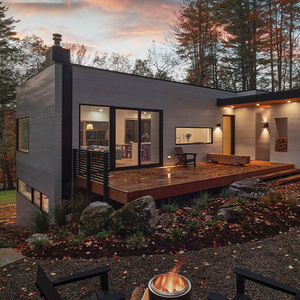In-wall kitchen exhaust duct?
Hi Friends, a question about ducting for kitchen exhaust fans. We are the top floor of a two-story condo building, built in the 50s. The unit below us has a kitchen directly below ours.
Currently there is a very large, maybe 16″ diameter, clay pipe that runs from the lower unit up through our unit to the roof. It is enclosed in the wall, but so big that the wall juts out into the kitchen and takes up a lot of space. We have a similar pipe that starts in our unit and runs on to the roof. These pipes were both the original exhaust vents, really more of a chimney than an exhaust, since there was probably no fan originally. They are both now unused, and both kitchens have NO exhaust.
Both units, top and bottom, would like to install real kitchen exhaust. My question is, how small can we (legally) make the exhaust duct passing from the downstairs unit as it goes up through our unit? Is there a rectangular exhaust duct that could be entirely or partially enclosed in the wall? What other solutions might there be (besides no exhaust at all, or a recirculating exhaust)?
If we can come up with a more compact way to move the downstairs kitchen exhaust through our unit, then we can reclaim some of the floor space taken up by this huge old chimney currently in place.
thanks for your help!



















Replies
Is there a rectangular exhaust duct that could be entirely or partially enclosed in the wall?
I bet there is. Your new hood will probably have a round outlet, and if so you can convert to rectangular and go up thru the wall. You should get a HVAC person on the job to figure out the best approach. You may have to furr out the wall slightly to fit the rectangular size you need in a single stud bay, and/or you may have to choose a hood that doesn't require a duct that's bigger than you can really fit.
Any chance the wall in question is an exterior wall?
>>>My question is, how small
>>>My question is, how small can we (legally) make the exhaust duct passing from the downstairs unit as it goes up through our unit?
Problem is, range hoods, especially good ones, benefit from large ducts. I found out the hard way when I plumbed a 4" duct when the unit called for a 6". This created all kinds of fluttering noise and poor performance. I eventually redid it in 6". Even 6" is small by many people's standards, depending on how many cubic feet per inch the fan is rated for.
Well, you shouldn't do anything without agreement from the neighbors below. (And you may need approval from the condo assoc as well. In fact, you almost certainly will, since the vents will terminate above the roofline.)
Next you need to determine what's the max size range hood that might be installed. This kinda depends on the size of the kitchen and the "class" of the condos. Basically you're asking "Will they ever want something more than the standard range hood?"
And you need to determine what fire codes may apply. Likely the duct from below must be enclosed in a fireproof surround of some sort, or be made of special fireproof duct.
But it seems reasonably likely that you can get the thickness of the duct (for a non-restaurant-grade hood) down to 6 inches or so, meaning you'd only have to bump out a standard 4" wall by 2-3 inches.
Note that you don't want to oversize too much, since then the low velocity will allow too much moisture to condense in the duct.
Rectangular duct?
DanH laid out many of the issues well - condo association, fire codes, etc.
To answer your original question, yes, rectangular duct is commonly used for kitchen hood exhaust (at least in my locale).
Many hoods have rectangular fittings / ports for exhaust - 3x12 and 4x10 are relatively common. You and the nieghbor need to figure out what size hoods you want and start researching from there. Rectangular ducting is generally transitioned to round when penetrating a roof, commonly left rectangular if venting through a sidewall.
In any event, I'm sure you will gain some floor space by removing the 16" clay pipes!
Jim
Need more information
Another thing you will need to know before sizing the duct is how many bends will be needed and the length of the duct from the range hood to the roof vent. Other considerations you may want to consider, especially for the duct coming from the lower unit, are accoustic issues. You will probably need to run the duct through a fire rated shaft for fire code, but you may want to double up the sheetrock for accoustic isolation.
Range hoods are notoriously loud but the good news is that the frequency at which they resonate is fairly easy to defeat. (No low base or impact noises). I also use a silicone fire caulk when I fit the ducts together just for a little extra protection. Silicone fire caulk isn't easy to get, you may have to special order it. Some bigger supply houses stock it.
I also forgot, that if you use a rectangular duct, you can get them made with an accoustic insulation attached to the outside. I forgot the name of the manufacturer but a good sheetmetal company will be sure to know. I'd personally stick with an 10" round for the bottom floor and maybe knock it down to a 8" for the top floor.
Legally.
the Code adopted by your AHJ (authority having jurisdiction or building department) will most likely defer to the manufacturer's installation instructions, which for a great many residential appliances form the legal basis for the code.
Question: What do you mean by "real" exhaust? A fart fan in the vent-a-hood light fixture over most residential ranges or some version of a commercial exhaust overkill. Or some reasonable exhaust system suited to a residential range?
If you want effective kitchen exhaust, then "how small can we legally...." is the wrong question. Pick a suitable exhaust hood, find out what the manufacturer recommends and then ask, "How can I make this work in my circumstances?"
A 4 inch round duct will pass exhaust of at most 35 CFM, 5 in round - about 60, 6" round - 100, 7" - 150 and 8" will pass about 200 CFM, all of course depnding on the specific of routing and terminations. All of these have rectangular and oval equivalents. The biggest you can get in a standard 16" o.c. 2x4 framed stud wall is a 3-1/4 x 14 "wall stack", the equivalent of a 7" round.
My thoughts are that 150 cfm is plenty of exhaust for most household kitchens. IF you do a lot of stir fry or blackening, you would want probably twice that.
Many Thanks, Everyone
Thank you all for your help.
Just to clarify, this is a project we are doing in cooperation with our downstairs neighbors, so it will be no problem working with them to figure out the best configuration. We two units make up the whole building, so we ARE the condo association. And of course we are going to follow the local codes. I just wanted to some guidance as to what was possible before getting started with drawings to take to the building department.
The downstairs kitchen exhaust is pretty much a straight shot right up to the roof. So Tim you are saying if they want about 150 CFM exhaust out of their unit, a standard 3 1/4 x 14 wall stack will do the job (more or less). If they need more (depending on what type of cooking they do and the type of exhaust fan they get) we can get a deeper rectangular vent and pop the wall out a few inches to accomodate it. This will be MUCH better than the current arrangement, which is a 16" x 40" box practically in the middle of the room.
Thanks also for the tips about the type of ducting. Pre-insulated acoustical will be a must. And I will make sure the construction meets whatever fire rating is required locally.
Thanks again, you've all helped a lot.
But note that the 3x14 duct won't (quite) fit in a standard 4.5" wall if it needs to be made fire-safe -- you'll need about another inch. (However, if this is only a 2-unit building you may not have to deal with as strict of fire codes as in a larger building.)
Where did you get these numbers?
4 inch round duct will pass exhaust of at most 35 CFM, 5 in round - about 60, 6" round - 100, 7" - 150 and 8" will pass about 200 CFM
I have measured fan flows from standard bath fans of between 75 and 100 CFM through 4" round rigid. I generally expect a good quality fan like a Panasonic to exhaust the rated volume if the duct is 8 feet or less and has no elbows.
Hold the phone. Ducting inside a wall may be easy, but maybe there is other issues. I'd check w/ the BO first. Stacked condos mean fire rating between them. Using sheet metal may require you maintain fire protection. Not sure how this type of occupancy would treat something like this.
In commercial construction a penetration through a fire separation (e.g. between rated floors), would require a fire damper be installed in the duct ... but that may pose a problem w/ range hood ductwork. Range hood ductwork isn't supposed to have 'stuff' in it that would catch grease.
I'm guessing a kitchen range hood may have one of the highest probabilities of fire in a house. Running up through rated construction may trigger other requirements ... be safe and check w/ the BO. If you don't and there is a fire, there could be some repercussions.
It's worth a check, I say. While sounding innocent, it may not be. Always good to get approval from the association and others you impact, but being safe is important, too.
If you check on it, let us know what he says.
Stop guessing
"I'm guessing a kitchen range hood may have one of the highest probabilities of fire in a house." That would be wrong. Guess again.
While many household fires start in the kitchen, they rarely start in the exhaust duct or hood. Unattending cooking, and catching of other items, towels and clothing, on fire being the most common. Electrical issues are the greatest cause of residential fires.
You seem to be better in the know about such statistics. I'll bet the kitchen fires are more spectacular, though! Yeah, right, they don't start in the exhaust duct usually; on the stove top, of course! But if that fan is on and that duct has grease in it ... wow ... you got something very serious going on there!!
Commercial
kitchen fires are a different issue, because the cooking fumes are much more heavily grease laden than that in a (typical) residence, and at a much higher temperature. Unless someone fries food in large quantities daily, most residential exhaust hoods remove primarily water vapor and, for bad cooks, smoke. Of course, commercial hoods, that comply with any mechanical code adopted in the last several decades, will have heavy black steel grease ducts, UL rated hoods (with grease baffles/traps) and fans and a chemical fire extinguishing system that is automatically actuated.